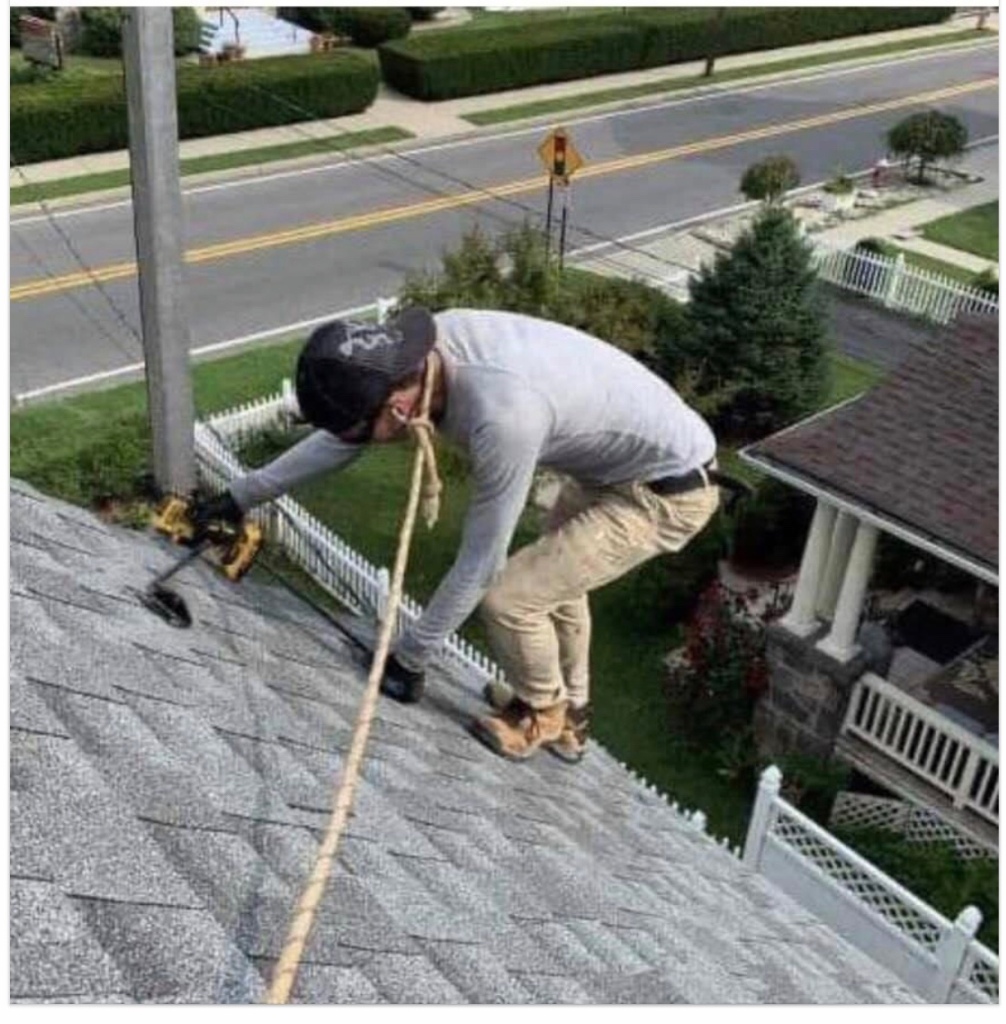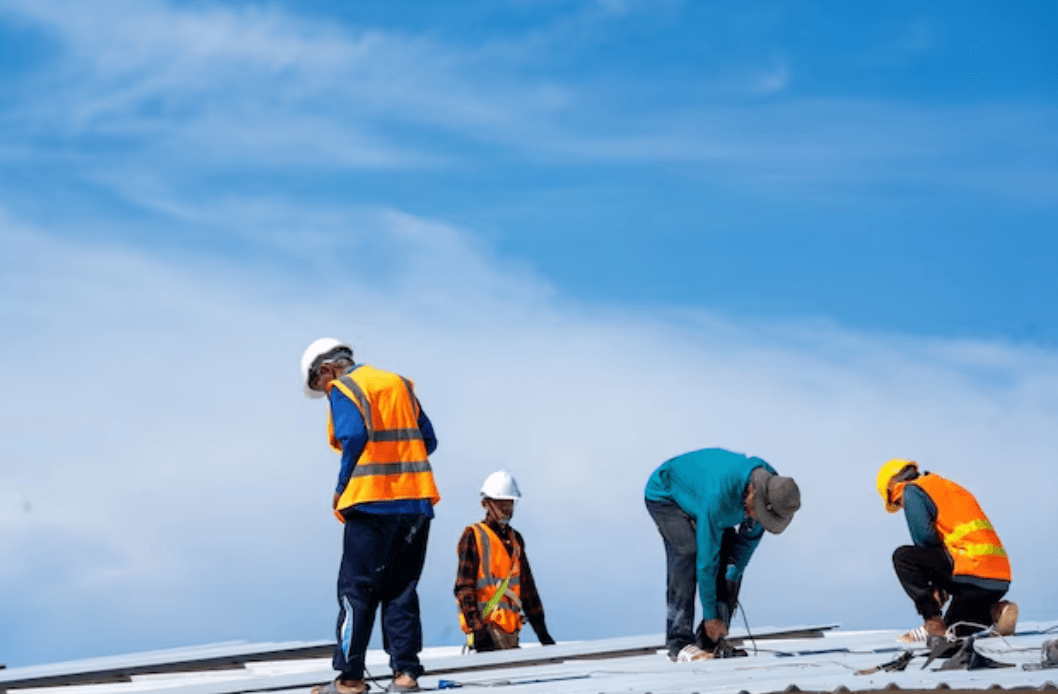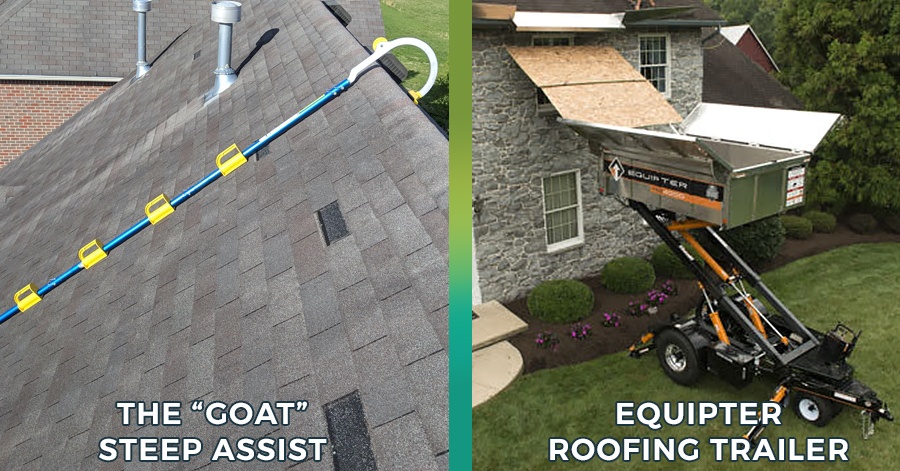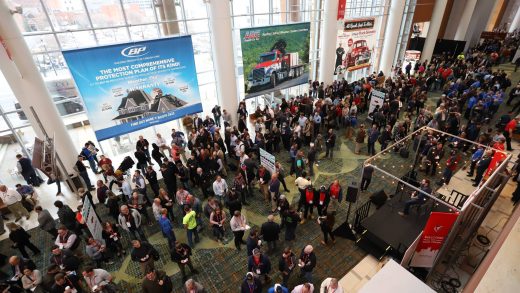
About Steep Roofs and How to Safely Work on Them

Steep roofs can add a unique and stunning look to any building, but they come with their own set of challenges when it comes to maintenance and repairs. Not only do these roofs require specialized techniques and equipment, but working on them also poses significant safety risks for those performing the job. Whether you’re a professional roofer or a DIY enthusiast, it’s crucial to understand how to safely work on steep roofs. In this blog post, we’ll explore essential safety gear, techniques for ascending and descending the roof without incident, weather considerations, emergency measures, ongoing training requirements, and legal aspects of working on steep roofs so you can tackle your next roofing project with confidence.
The Risks of Working on Steep Roofs
When it comes to roofing work, steep roofs present a unique set of challenges and risks that must be taken into account. The angle of the roof can make it difficult to maintain balance and footing, increasing the risk of falls and injuries.
One major risk associated with working on steep roofs is the potential for slips or trips. Even if you are able to maintain your balance while ascending or descending the roof, there may be loose shingles or other hazards that could cause you to slip.
Falls are another significant concern when working on steep roofs. Without proper safety equipment and precautions in place, a fall from even a relatively low height can result in serious injury or death.
In addition to these physical risks, there are also environmental factors that can impact safety when working on steep roofs. High winds, rain, snow, and other weather conditions can create additional hazards for workers by making surfaces slippery or unstable.
It’s essential for anyone working on steep roofs to take all necessary safety precautions before beginning any work. From wearing appropriate gear like harnesses and helmets to evaluating roof conditions before starting work, every step should be taken to minimize risks as much as possible.
Essential Safety Gear for Steep Roofing Work
When it comes to working on steep roofs, safety should always be the top priority. One of the most important things you can do to stay safe while working on a roof is to wear the right gear.
First and foremost, a good safety harness is absolutely essential for steep roofing work. A harness will anchor you securely to the roof and prevent falls from happening in case of slips or missteps.
In addition to your safety harness, other crucial pieces of safety equipment include specialized roofing boots with non-slip soles that provide extra grip even when conditions are wet or icy.
You’ll also want gloves that offer plenty of protection against sharp edges as well as helmets that protect your head from falling debris or accidental collisions with low overhangs.
Other protective equipment may include knee pads, eye protection, and earplugs depending on the specific job requirements and conditions at hand.
Safety Harnesses and Anchors
Safety Harnesses and Anchors are essential components for workers who need to perform roofing work on steep roofs. These safety tools work together to keep workers safe from falls, which can lead to serious injuries or even death.
When working on a steep roof, it’s crucial to wear a safety harness that is securely anchored to the roof. The anchor should be installed in such a way that it can withstand the weight of the worker and any equipment they may be carrying. There are different types of anchors available depending on the type of roofing material and pitch of the roof.
The harness must fit properly so that it won’t come loose during work. It must also have strong straps and buckles, as well as an adjustable lanyard length so that it doesn’t restrict movement while still keeping the worker within reach if they fall.
It’s important not only to use these devices but also inspect them before each use. Check all components for damages or malfunctions by following manufacturer instructions carefully. If you find something wrong with your safety gear don’t hesitate – replace damaged parts right away!
Using Safety Harnesses and Anchors is just one part of comprehensive Roofing Safety Equipment needed when working at heights above ground level. Always remember: Safety first!
Roofing Boots and Gloves
When it comes to working on steep roofs, having the right safety gear is crucial. One of the most important pieces of equipment for roofing work are boots and gloves specifically designed for this type of job.
Roofing boots should have excellent grip and be slip-resistant, as well as offering ankle support. They should also come with steel toes to protect your feet from falling debris.
Gloves are equally important, providing protection against sharp edges and hot surfaces. A good pair of gloves will also improve your grip while handling tools or materials on a sloped surface.
It’s essential that both boots and gloves fit properly so they don’t slip off or become uncomfortable during work. Investing in quality gear can mean the difference between a safe day on the roof or an accident waiting to happen.
Remember to inspect your gear regularly for signs of wear and tear, replacing them when necessary. Taking these steps will help ensure that you’re always prepared for whatever challenges may arise when working on steep roofs.
Helmets and Other Protective Equipment
When it comes to working on steep roofs, helmets and other protective equipment are crucial for ensuring your safety. A helmet is one of the most essential pieces of gear you should wear when working on a roof because it protects your head from falling objects or accidental slips.
In addition to a helmet, you will also need other protective equipment such as eye protection goggles or glasses, earplugs or earmuffs to protect your hearing from loud noises produced by power tools.
You can never underestimate the importance of wearing gloves when roofing. They not only provide grip but also offer protection against sharp edges and materials that may cause cuts and abrasions. Roofing boots with good traction are equally important as they provide stability while walking on steep slopes.
It’s worth noting that all protective gear must comply with occupational health and safety standards. It’s essential to ensure that every piece of gear fits properly before starting any work. This includes adjusting straps accordingly so they fit snugly around your head, ears, chin, wrists, etc.
Remember: prevention is always better than cure! A small investment in quality personal protective equipment can save lives in case an accident occurs during roofing projects.
Understanding Roof Pitch and How It Impacts Safety
The roof pitch is an essential factor that affects the safety of working on a steep roof. The pitch refers to the slope or angle of the roof, which is determined by measuring its rise over run. A steeper pitch means a higher angle.
Measuring Roof Pitch
To measure your roof’s pitch, you can use a level and tape measure to determine the vertical rise in inches for every 12 inches horizontally (run). You can also use an online tool or app to get an accurate measurement.
Impact of Roof Pitch on Safety Precautions
Roofing work becomes more challenging as the pitch gets steeper because it requires more physical effort to maintain balance and hold onto equipment. Steeper roofs have a greater potential for falls, making it vital to take extra precautions when working on them.
Safety Precautions Before Starting Work
Before starting any roofing work, evaluate the condition of your ladder, harnesses/anchors, protective gear such as boots/gloves/helmets, and other materials used in roofing work. Ensure everything is secure before ascending up high into steep areas where one small mistake could lead towards injuries.
Techniques for Safely Ascending and Descending a Steep Roof
It’s essential not only to climb up but also descend from steep roofs safely using proper techniques like maintaining three points of contact at all times with both feet firmly planted on solid ground while securing yourself with ropes anchored securely around you before beginning any roofing tasks.
In conclusion: A thorough understanding of how roof pitches affect safety measures enables workers who deal with steep roofs daily to better safeguard themselves while doing their jobs effectively without risking grave injury or even death due to falling off unprotected rooftops.
How to Measure Roof Pitch
Measuring the roof pitch is essential for determining safety precautions when working on a steep roof. Roof pitch refers to the angle of the sloping surface of a roof and is typically expressed in terms of how much rise there is per every 12 inches (or “run”) of horizontal distance.
To measure the pitch, you’ll need a level measuring tool, such as a carpenter’s level or an electronic inclinometer. Place one end of your measurement tool at any point along the edge of your roof and hold it perfectly horizontal. Then, measure vertically upward from that point to where it intersects with your tool.
Next, calculate the slope by using basic trigonometry and divide the rise by run. This will give you your “pitch” as either an angle in degrees or as a ratio like 4:12 or 6:12.
It’s important to note that knowing your roof pitch alone won’t guarantee safety when working on steep roofing projects – this information only helps determine what kind of equipment and training might be needed before beginning work.
The Impact of Roof Pitch on Safety Precautions
The pitch of a roof, or its slope, is an important factor to consider when planning for roofing work. Steeper roofs present greater risks and require more precautions than flatter ones.
Roof pitch can impact the type of safety gear needed for work on the roof. For example, steeper roofs may require special boots with better grip and traction, as well as harnesses that are rated for higher weights and have longer straps to accommodate taller heights.
In addition, roofing techniques may differ depending on the pitch of the roof. Working on a steep roof requires different balance and footing strategies than working on a flatter one. The angle of inclination also affects how easily tools can slide down from the rooftop.
Moreover, weather conditions such as rain or snow are more hazardous when combined with steep slopes because they create slippery surfaces that increase risk factors during roofing work.
Understanding how roof pitch impacts safety precautions is crucial before starting any roofing job. Taking extra time to evaluate potential hazards based on slope will ensure workers’ protection against accidents and injuries while executing their tasks diligently.
Safety Precautions Before Starting Work on a Steep Roof
Before starting any work on a steep roof, it is essential to take the necessary safety precautions to reduce the risk of accidents and injuries. The following are some critical safety measures that must be taken before commencing any roofing work.
Firstly, it is vital always to check the weather conditions before climbing onto a steep roof. If there’s rain or high winds predicted, then postpone the job until another day as these conditions make working on a sloping surface incredibly hazardous.
Secondly, inspecting all equipment and tools used in roofing work can help avoid injury. Ensure all ladders have no missing pieces or cracks; harnesses are secure and ropes untangled.

Thirdly, begin by creating an access plan for reaching all areas of the roof safely. Identify safe anchor points where anchors can be secured into solid parts of the house frame securely.
Fourthly, ensure you have someone assisting you from below with both communication devices if possible in case of emergencies.
Wear clothing that provides full coverage – long sleeves and pants – including non-slip shoes or boots with good traction soles capable of gripping even wet surfaces when ascending or descending roofs safely.
Evaluating the Roof Condition
Before beginning any work on a steep roof, it’s essential to evaluate the condition of the roofing structure. This step is critical in ensuring that you can identify and address any existing or potential hazards before starting your work.
The first thing to look for when assessing a roof’s condition is its age. Older roofs may have decayed shingles, warped materials, and weakened structures that could increase the risk of accidents while working on them.
Next, examine the surface of the roof carefully. Look out for deformities such as sagging areas, dips or cracks because they might indicate structural damage or wear and tear over time.
Additionally, check whether there are any leaks within the interior part of the building since this might suggest water infiltration through damaged points on top of your roof.
It’s also vital to assess if there is debris like leaves trapped between shingles or flashing around chimneys/vents causing blockages leading to water buildup which will eventually lead to rotting wood deck underneath shingles.
By evaluating these factors beforehand, you’ll be able to determine what safety measures need implementing during your work. Remember that even small issues like loose tiles can cause significant problems later on if ignored; therefore taking steps ahead will ensure successful completion with minimal hiccups along the way.
Techniques for Safely Ascending and Descending a Steep Roof
When it comes to working on steep roofs, safely ascending and descending the roof is a crucial part of the job. Here are some techniques that can help you do so safely:
First and foremost, ensure that your ladder or other equipment is securely anchored to the ground before attempting to climb up onto the roof. Use a sturdy extension ladder designed for roofing work, with rubber feet and non-slip rungs.
Once you have climbed up onto the roof, use a safety harness attached to an anchor point that has been securely installed into the structure of your home. This will provide an additional layer of protection against falls while you are working.
When descending from a steep roof, always face towards the ladder or other descent equipment and keep both hands free for gripping onto handholds or railings as needed. Take your time when climbing down – rushing can lead to slips or falls.
If using rope access techniques such as rappelling to descend from a steep roof, make sure that all ropes are properly secured and anchored before beginning your descent. Use specialized gear designed specifically for rope access work in order to minimize risk.
Remember: safety should always be your top priority when working on any type of roofing project!
Working Safely on the Roof
Working on a steep roof can be dangerous, but with the right safety precautions and equipment, it’s possible to do so safely. Here are some tips for working safely on the roof:
Firstly, ensure that you have the appropriate safety gear before starting work on a steep roof. This includes a safety harness and anchor system, roofing boots and gloves, as well as helmets and other protective equipment.
Next, always make sure that you understand the pitch of the roof – this will impact your safety precaution needs. Use an inclinometer or an app to measure it accurately.
When ascending or descending a steep roof, use proper techniques such as climbing ladders secured to the roof or using ropes linked to anchors positioned securely into studs in structural elements of your house.
Once you’re up there, start by securing yourself with your harness before beginning any work. Be mindful of where you place tools like hammers and drills while doing repairs; they should not slide off easily causing slippage.
Finally, it’s important to take regular breaks when working on roofs due to fatigue caused by sunlight exposure at high altitudes – even in cooler weather conditions!
Breaks and Weather Considerations
When working on a steep roof, taking breaks is an important aspect of maintaining safety. It’s natural for the body to tire more quickly when working at height, so workers should plan regular rest periods throughout the day. This will help prevent fatigue and reduce the risk of accidents caused by over-exertion.
It’s also crucial that roofing professionals consider weather conditions before starting work on a steep roof. Extreme heat or cold can affect both physical performance and mental alertness. On hot days, workers must stay hydrated and take regular breaks in shaded areas to avoid heat stroke or exhaustion. During cold weather, clothing layers are necessary to keep warm but shouldn’t hinder movement.
Rainy or windy conditions can make it difficult to maintain balance while working on a steep roof. Workers should assess weather forecasts regularly and reschedule work if possible during unfavorable conditions like high winds or severe storms.
In summary, taking frequent breaks helps reduce fatigue levels while considering extreme weather maximizes worker safety in every type of hazard that may come along with it when working on steep roofs.
Emergency Measures for Steep Roof Safety
In the event of an emergency on a steep roof, it is essential to have a plan in place beforehand. One of the most important steps is having access to a functioning phone or radio for immediate communication with emergency services. It’s also crucial to have first aid supplies and equipment readily available.
If someone falls or gets injured while working on a steep roof, quick action can make all the difference. If possible, call for medical help immediately and try to keep the person calm and still until help arrives. Depending on their injuries, you may need to administer first aid before paramedics arrive.
Another critical factor in preventing emergencies is staying aware of weather conditions at all times. High winds, rain, snow, or ice can increase risks significantly when working on steep roofs – so it’s better not to work during those conditions.
If an emergency does occur while working on a steep roof that requires evacuation from height quickly – such as fire – then everyone must know what they should do in advance; this includes how they will exit safely using ladders or other means prepared beforehand.
Training for Steep Roof Work
Training is crucial for anyone who wants to work on steep roofs. This type of work requires specific skills and knowledge that can only be acquired through proper training. To ensure safety, it’s important to learn the best practices for working on these types of roofs.
One essential aspect of training is understanding the risks associated with steep roof work. Trainees should learn about the potential hazards such as falls, slips, and equipment failure. They should also know how to identify unsafe conditions and what steps they need to take in case something goes wrong.
Another vital component of training is learning how to use all equipment safely. The trainee should understand its purpose, limitations, or restrictions before using them while working at heights.
Moreover, workers must be familiarized with different roofing techniques and methods used in steep roof installations and repairs. They must understand how each technique impacts their safety when performing their duties.
It’s essential that workers receive practical hands-on experience during their training sessions before being allowed to work unsupervised on a job site. This allows them an opportunity to apply what they have learned under expert guidance.
By providing comprehensive training programs specifically tailored for working on steep roofs, which includes theoretical and practical lessons, will help minimize accidents that may occur while carrying out this kind of difficult job given its nature – high risk!
Ensuring Ongoing Safety in Steep Roof Work
Ensuring ongoing safety in steep roof work is crucial for both the workers and homeowners. This involves implementing effective safety protocols, performing routine inspections, and continuous training of employees to maintain a safe working environment.
One way to ensure ongoing safety is by providing regular maintenance checks on equipment such as ladders, harnesses, ropes, and anchors. These items can become damaged or worn over time, which can compromise their effectiveness during a job.
Another critical aspect of ensuring ongoing safety is providing comprehensive training for employees. Workers need to be well-versed in all aspects of roofing techniques and procedures, including how to use equipment correctly and what emergency measures should be taken if an accident occurs.
Additionally, using proper signage around the worksite helps keep everyone informed about potential hazards like falling debris or slippery surfaces. It’s also important that workers follow strict guidelines when it comes to taking breaks from work so they don’t become fatigued or prone to errors while up on the roof.
Communication between team members is vital in maintaining an overall safe working environment as this promotes awareness about risks associated with specific actions undertaken on steep roofs.
By continuously enforcing these measures along with others not mentioned here like creating contingency plans in case of emergencies – one can help minimize risks associated with steep roof work, thereby promoting a safer workplace for everyone involved.
Legal Aspects of Steep Roof Work Safety
When it comes to working on steep roofs, safety is paramount. However, there are also legal considerations that must be taken into account. In many jurisdictions, employers have a legal obligation to provide their workers with a safe environment in which to work.
This means that if an employee is injured while working on a steep roof due to inadequate safety measures or training, the employer may be held liable. Consequently, it’s essential for both employers and employees to ensure they’re following all relevant regulations and guidelines regarding roof safety.
It’s important for workers who are required to work on steep roofs to receive proper training not only in terms of safety techniques but also in the proper use of equipment such as harnesses and anchors. This can help prevent accidents and reduce liability risks.
Employers should also make sure that they routinely assess the condition of their roofs and take necessary steps towards repair or maintenance when needed. Neglecting these responsibilities exposes both employees and employers alike to unnecessary risk.
By prioritizing roofing safety education, providing adequate protective gear, ensuring regular inspections are conducted for repairs/maintenance needs, businesses can maintain compliance with relevant laws while reducing injury risks for their team members involved in dangerous tasks like roofing at heights.
Conclusion
Working on steep roofs can be a dangerous task. However, with the right safety equipment, training, and techniques in place, it is possible to safely work on these types of roofs. It is important to always prioritize safety first before starting any roofing project. This means ensuring that you have all the necessary protective gear, such as harnesses, anchors, and helmets, and understanding how to properly use them.
Additionally, it’s crucial to evaluate the roof condition beforehand and determine if there are any repairs or maintenance needed prior to commencing work on it. Always take regular breaks throughout your workday while keeping an eye out for weather changes that may impact your safety.
Remember that ongoing training is essential for anyone involved in steep roof work, whether they are contractors or DIYers. Keep up-to-date with new roofing techniques and technologies so that you can always ensure safe practices when performing this type of work.
By following these guidelines outlined above, along with common sense measures like staying alert at all times when working on a roof, will help minimize accidents while maximizing productivity during each job you perform!


